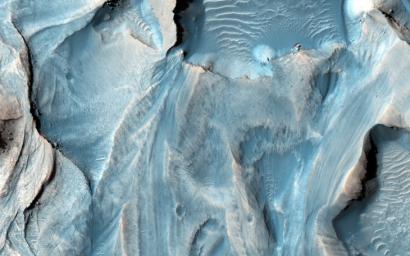
|
Possible Cyclic Bedding within a Crater in Arabia Terra
- Click the image above for a larger view
- Full-Res JPEG (2880 x 1800) (749.6 kB)
- Full-Res TIFF (2880 x 1800) (15.6 MB)
Caption:
This observation covers an outcrop of possible cyclic bedding within a crater in Arabia Terra.
"Cyclic bedding" refers to a pattern of layering caused by repeated fluctuations in the amount of available sediment that creates new rock layers . These fluctuations are caused by long-term changes in the region's climate, with periods on the order of millions, or possibly hundreds of millions of years. It's possible that even the wobble of the planet might be a contributing factor to cyclic bedding.
An image at HiRISE resolution can help evaluate the cyclicity of the beds, as well as test possible regional stratigraphic correlations, and perhaps, indications of a wetter past environment.
Background Info:
HiRISE is one of six instruments on NASA's Mars Reconnaissance Orbiter. The University of Arizona, Tucson, operates the orbiter's HiRISE camera, which was built by Ball Aerospace & Technologies Corp., Boulder, Colo. NASA's Jet Propulsion Laboratory, a division of the California Institute of Technology in Pasadena, manages the Mars Reconnaissance Orbiter Project for the NASA Science Mission Directorate, Washington.
Cataloging Keywords:
| Name | Value | Additional Values |
|---|---|---|
| Target | Mars | |
| System | ||
| Target Type | Planet | |
| Mission | Mars Reconnaissance Orbiter (MRO) | |
| Instrument Host | Mars Reconnaissance Orbiter | |
| Host Type | Orbiter | |
| Instrument | High Resolution Imaging Science Experiment (HiRISE) | |
| Detector | ||
| Extra Keywords | Color, Crater | |
| Acquisition Date | ||
| Release Date | 2013-08-08 | |
| Date in Caption | ||
| Image Credit | NASA/JPL-Caltech/Univ. of Arizona | |
| Source | photojournal.jpl.nasa.gov/catalog/PIA17635 | |
| Identifier | PIA17635 | |
